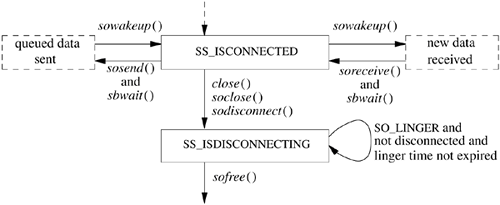11.7. Socket Shutdown Although closing a socket and reclaiming its resources at first glance appears to be a straightforward operation, it can be complicated. The complexity arises because of the implicit semantics of the close system call. In certain situations (e.g., when a process exits), a close call is never expected to fail. However, when a socket promising reliable delivery of data is closed with data still queued for transmission or awaiting acknowledgment of reception, the socket must attempt to transmit the data, perhaps indefinitely, for the close call to maintain the socket's advertised semantics. If the socket discards the queued data to allow the close to complete successfully, it violates its promise to deliver data reliably. Discarding data can cause naive processes, which depend on the implicit semantics of close, to work unreliably in a network environment. However, if sockets block until all data have been transmitted successfully, then, in some communication domains, a close may never complete! The socket layer compromises in an effort to address this problem yet maintain the semantics of the close system call. Figure 11.13 (on page 464) shows the possible state transitions for a socket from a connected to a closed state. In normal operation, closing a socket causes any queued but unaccepted connections to be discarded. If the socket is in a connected state, a disconnect is initiated. The socket is marked to indicate that a file descriptor is no longer referencing it, and the close operation returns successfully. When the disconnect request completes, the network support notifies the socket layer, and the socket resources are reclaimed. The network layer may attempt to transmit any data queued in the socket's send buffer, although there is no guarantee that it will. However, commonly used connection-oriented protocols generally attempt to transmit any queued data asynchronously after the close call returns, preserving the normal semantics of close on a file. Figure 11.13. Socket-state transitions during shutdown. 
Alternatively, a socket may be marked explicitly to force the application process to linger when closing until pending data have drained and the connection has shut down. This option is marked in the socket data structure using the setsockopt system call with the SO_LINGER option. When an application indicates that a socket is to linger, it also specifies a duration for the lingering period. The application can then block for as long as the specified duration while waiting for pending data to drain. If the lingering period expires before the disconnect is completed, the socket layer then notifies the network that it is closing, possibly discarding any data still pending. Some protocols handle the linger option differently. In particular, if the linger option is set with a duration of zero, the protocol may discard pending data rather than attempt to deliver them asynchronously. |